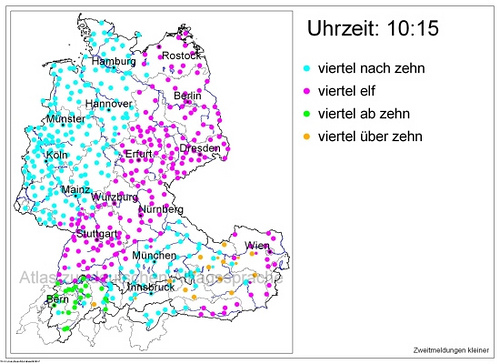Time in German
Frank Jacobs explains how "in German, you can tell with some degree of certainty which general area someone hails from by the way they tell the time at quarter past ten."
Frank Jacobs examines regional variation in expressing time in Germany.
Germans have a reputation for punctuality. Is that why they have so many ways of telling the same time? If it’s 10:15 in the germanosphere, you’ll have at least four options of expressing that particular moment. Those four options are all regional variants, so that, in German, you can tell with some degree of certainty which general area someone hails from by the way they tell the time at quarter past ten.
This isogloss map shows that in a large part of north-western Germany, from the Danish to the French border, the preferred option is viertel nach zehn (‘quarter after ten’). This viertel is considered a fixed point in time, and its point of reference is the previous full hour.
Remarkably, the eastern boundary of this area is to a large extent identical to the former border between West and East Germany. It includes all or most of the German Länder of Schleswig-Holstein, Hamburg, Bremen, Lower Saxony, North Rhine-Westphalia, Hessen, the Rhineland-Palatinate and the Saarland (as well as Luxembourg and the German-speaking area of Belgium).
In what used to be East Germany , the same clock time is referenced as viertel elf (‘quarter eleven’). This viertel is not a point in time, but a period of time, i.e. one-fourth of the next hour. This area doesn’t stop at the former German-German border, but extends into northern Bavaria and Baden-Württemberg.
An option limited to German-speaking Switzerland is to call this particular time viertel ab zehn (‘quarter from ten’). Like the first viertel, this one is distanced from the previous hour by a preposition, albeit not a unidirectional one. In theory, this moment could both be before or after ten. Common usage will probably make such confusion improbable (although it would be interesting to know whether this option is as unambiguous for non-Swiss German speakers).
Another national Option is viertel über zehn (‘quarter over ten’), used only in central parts of Austria (5). In much of the rest of Austria, as well as in adjoining parts of Germany (southern Bavaria) and Italy (southern Tyrol), we see the recurrence of the north-western option, whereas the east and south of Austria repeat the East German option.
Most of my time in Germany was spent in Rheinland Pfalz or Hessen, so the “viertel nach zehn” variant is what I learned. Unless my memory is failing me (and it has been almost two decades), “viertel elf” was 10:45, that is “a quarter to eleven.”
Although I wonder if this is distinction still matters? In the United States, at least, the ubiquity of digital time-telling devices (whether it be watches, mobile phones, or the computer) has just about wiped out folksy variants in favor of precise numbers: “ten-thirteen, ten-fourteen, ten-fifteen” and so on.
via Zoe Pollock







My German experience is limited to high school and 16 hours in college, so it was primarily Hoch Deutsch.
We learned “viertel nach zehn” for 10:15. “Viertel elf” was 10:45.
Actually, I think you are remembering “drei-viertel elf” (“three quarters of eleven”) as the common way to say 10:45. The fractions express the part of the upcoming hour that has past. A very common way (common to all of the German-speaking areas, so far as I know) to say “ten-thirty” (10:30) is “halb elf” (“half of eleven”).
I spent 5 months in high school in Bremen, and 10 months in college in Baden (Austria, near Vienna), i.e. at opposite ends of the “deutscher Sprachraum”, and I recall the “drei-viertel elf” idiom in both areas. I’ve never been to Switzerland, and I’ve never heard “viertel ab zehn”, but it and “viertel über zehn” make sense. And though “drei-viertel elf” was very common for 10:45, I don’t recall ever hearing “viertel elf” for 10:15, but then I spent very little time in eastern or southwestern Germany.
Interesting post! I have an M.A. in German, but you taught me some things I didn’t know (not that there isn’t plenty that I don’t know).
I whether some of the distinction is part of the Hochdeutsch/Plattdüütsch (linguistically speaking) development that occurred centuries ago. And, of course Schwyzertütsch is a highly idiosyncratic dialect of its own.
I don’t think the Hoch/Platt division per se is operative in the “viertel elf/viertel nach zehn” division because the isogloss runs right down the middle of the Low German region, dividing the western and northern Platt variants from the eastern variants.
Based on the map, it looks like I should have been hearing “viertel elf” instead of “viertel nach zehn” in the part of Austria (Lower Austria) I was in as an exchange student. I don’t particularly recall hearing it, but there were so many features of Niederösterreichisch/Weanerisch that were more remarkable that I may just not have noticed it.
I don’t think it’s the only operative factor but the dividing line looks suspiciously like the Hoch/Platt division line. My guess is that when you add topography and political boundaries into the mix it goes a long way towards explaining the variants.
Really, it’s not much like the Hoch/Platt line at all. “viertel nach zehn” streteches way down into the Central German dialect region (Kölnisch, Hessisch, Rheinländisch, the Saarland), and the dialects of Mecklenburg and Vorpommern (which are every bit as Platt as the dialects of Niedersachsen and Westfalen) fall on the “viertel elf” side of the isogloss. Consider this map, which highlights the regions that fall into the Central German category: .